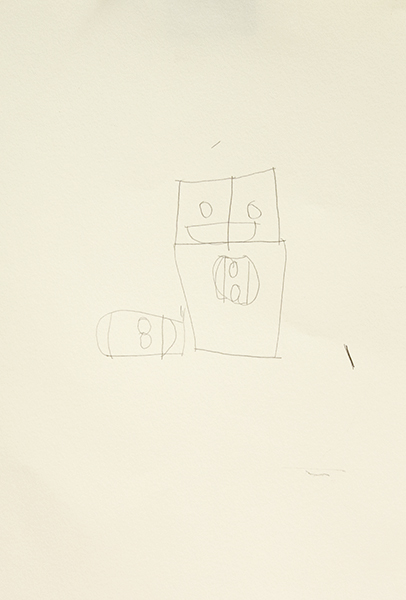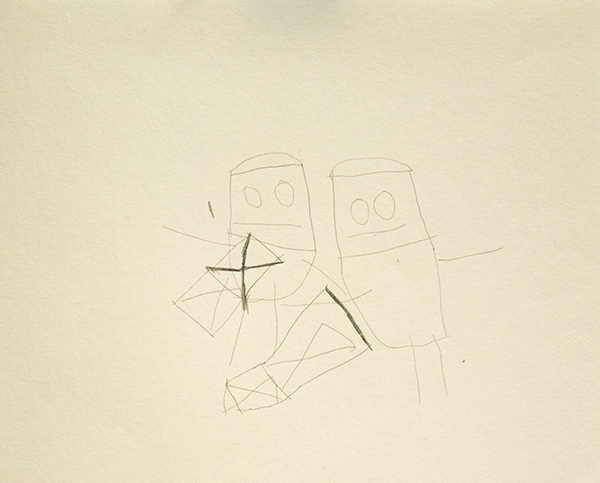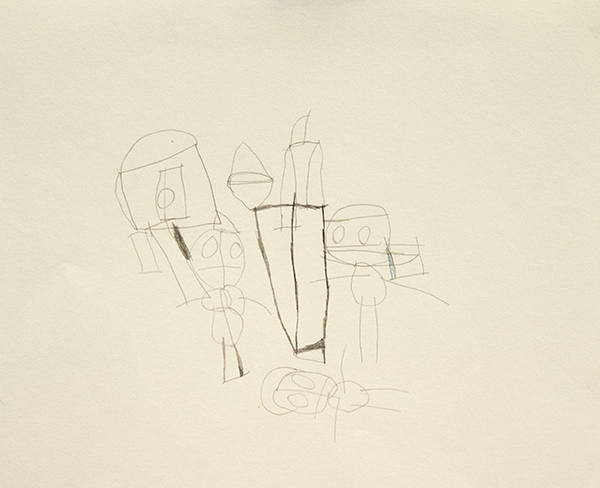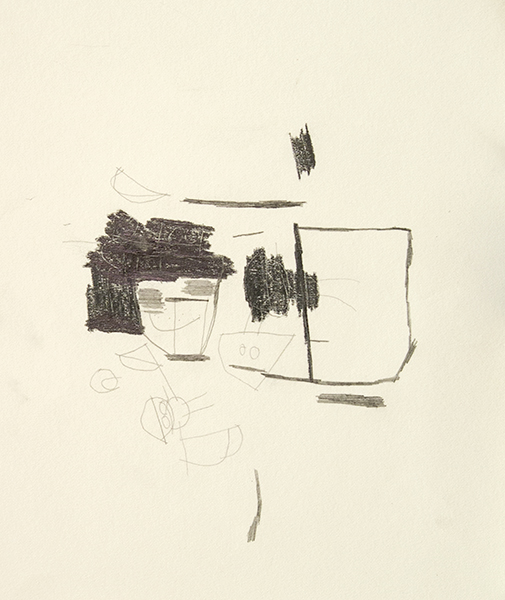Storytellers is a selection of works by artists who reimagine and reinvent the essential practice of telling stories through visual art. Each work represents aspects of a complex personal narrative, glimpses into alternate realities created with diverse materials and processes...
Read MoreMapping Fictions: Daniel Green
Daniel Green, Fifteen People, 2009, Mixed media on wood, 14.25 x 22.5 x 1.75 inches
Daniel Green, Little Mac vs Soda Poponski, 2015, mixed media on wood, 11.5 x 15 inches
Daniel Green, The Sun, 2015, mixed media on wood, 6 x 16.5 x 1 inch
Daniel Green, Business Delivery, 2011, Mixed media on wood, 13 x 29 x 1 inches
Daniel Green's process is slow and intimate; quietly hunched over his works in the bustling studio, he draws and writes at a measured pace. These detailed works are an uninhibited visual index of Green’s hand; when read carefully, they become jarring and curious, slowly leading the viewer to meaning amid the initial incoherence. Green’s text is poetic and complex - language and thought translated densely from memory in ink, sharpie, and colored pencil on robust panels of wood. Figures and their embellishments are drawn without a hierarchy in terms of space occupied on the surface; they are at times elaborate and at other times profoundly simple. The iconic figures’ facial expressions (Jesus, Abraham Lincoln, Tina Turner, video game characters, etc.) are generally flat with proportions stretching and distorting subject to Green’s intention.
Ultimately, these drawings compel the viewer to internalize and decipher Green’s ongoing, non-linear narrative. His drawings call to mind Deb Sokolow’s humorous, text-driven work, but are less diagrammatic and concerned with the viewer. In an interview with Bad at Sports’ Richard Holland, Sokolow elaborates on her process:
I’ve been reading Thomas Pynchon and Joseph Heller lately and thinking about how in their narratives, certain characters and organizations and locations are continuously mentioned in at least the full first half of the book (in Pynchon’s case, it’s hundreds of pages) without there being a full understanding or context given to these elements until much later in the story. And by that later point, everything seems to fall into place and with a feeling of epic-ness. It’s like that television drama everyone you know has watched, and they tell you snippets about it but you don’t really understand what it is they’re talking about, but by the time you finally watch it, everything about it feels familiar but also epic. (Bad At Sports)
Much like Sokolow, Green engages in making work that begins with the rigorous practice of archiving information culled from his surroundings and interests, which then develops into intriguing, fictitious digressions. Dates and times, tv schedules, athletes, historical figures, and various pop culture references flow through networks of association - “KURT RUSSEL GRAHAM RUSSEL RUSSEL CROWE RUSSEL HITCHCOCK AIR SUPPLY ALL OUT OF LOVE…” Although the listing within his work sometimes gives the impression of being intuitive streams of consciousness, most of it proves to be very structured and complex within Green’s system. Rather than expression or even communication, the priority seems to be the collection of information or organization of ideas; the physical encoding of incorporeal information as marks on a surface is a method for making it tangible, possessable, and manageable.
Daniel Green, Pure Russia, 2011, Mixed media on wood, 9 x 23 x 3.5 inches
Pure Russia (detail)
From the perspective that Green invents, there’s an endless number of time sequences that haven’t been considered before. A grid of days and times (as in Pure Russia) imagines time passing in increments of one day and several minutes, then returns to the beginning of the series, stepping forward one hour, and proceeding again just as before. It could be cryptic if you choose to imagine these times having a relationship to one another, or it could instead be an original rhythm whose tempo spans days, so that it can only be understood conceptually as an ordered structure mapped through time - the significance of the pattern superseding that of specific moments.
By blurring the distinction between the articulation of ideas through text and the development of mark-making, Green’s highly original objects become unexpectedly minimal and material, yet simultaneously personal and expressive.
Daniel Green’s work will be included in Mapping Fictions, an upcoming group exhibition opening July 9th at The Good Luck Gallery in LA, curated by Disparate Minds writers Andreana Donahue and Tim Ortiz. Green has exhibited previously in Days of Our Lives at Creativity Explored (2015), Create, a traveling exhibition curated by Lawrence Rinder and Matthew Higgs that originated at University of California Berkeley Art Museum and Pacific Film Archive (2013), Exhibition #4 at The Museum of Everything in London (2011), This Will Never Work at Southern Exposure in San Francisco, and Faces at Jack Fischer Gallery in San Francisco.
Deveron Richard
Sectra Shower, watercolor on paper, 18" x 24”, 2014
The Milkets, watercolor on paper, 26" x 32”, 2015
The Planets, watercolor on paper, 17.25" x 23.5”, 2009
A Border Between Unicorns, watercolor on paper, 19" x 25.5”, 1996
Deveron Richard maintains a creative practice at one of many ECF art centers in the LA area (previously discussed by Disparate Minds in terms of their relationship to DAC Gallery). His inaugural solo show is currently on view in LA at the Good Luck Gallery through May 21st. From the Good Luck Gallery:
“An idiosyncratic iconography of visionary space travel and anthropomorphic sexuality arrives via the South Bay of Los Angeles through the singularly fertile imagination of Deveron Richard. Winged horses in brassieres and high heels glide peacefully around the cloud-enshrouded towers of a futuristic city, polar bears in lipstick and slit dresses prance through a fluorescent arctic landscape, and provocatively-attired unicorns face off on a hallucinatory geometric color grid. These hybrid creatures of exaggerated femininity exude a quirky eroticism. Rendered in watercolor with a distinctively saturated palette, inventive draftsmanship and hypnotic backdrops of complex rhythmic patterning. Other works depict interplanetary battles with rockets hurtling through galaxies and deadly beams shooting into space.”
Marvin Asino
From the Disparate Minds collection: “For all of my friends and one basketball player” is a zine containing 21 poems interpreted from the text works of Marvin Viloria Ariza Asino. It’s sensibility can be described using Marvin’s own words “rhythm; kind, beautiful, friendly.” Asino writes in a matter-of-fact manner (siding in a space where humor and simple, profound truths meet), so the force of its beauty comes entirely by surprise with a wonderful sense of mystery.
This anthology was given in the course of a conversation with one of Marvin’s many friends, Robert Grey, at Full Life, in Portland Oregon last year. An updated overview of Full Life, a very different kind of program, will be posted soon.
NEW VOICES
Throughout 2015, Disparate Minds writers Tim Ortiz and Andreana Donahue worked directly with The Canvas, a progressive art studio in Juneau, Alaska as Artists-In-Residence, guest facilitators, and curators of the group exhibition NEW VOICES.
Read MoreGrace Coenraad
Grace Coenraad, Untitled, micron, sharpie, graphite, and india ink on paper, 2015, 16" x 16"
Grace Coenraad, Untitled, micron, sharpie, and india ink on paper, 2015, 22" x 22"
When I first painted a number of canvases grey all over (about eight years ago), I did so because I did not know what to paint, or what there might be to paint: so wretched a start could lead to nothing meaningful. As time went on, however, I observed differences of quality among the grey surfaces – and also that these betrayed nothing of the destructive motivation that lay behind them. The pictures began to teach me. By generalizing a personal dilemma, they resolved it.
Gerhard Richter, From a letter to Edy de Wilde, 23 February 1975
Coenraad’s dark, minimalist works are the product of a measured and slow process, executed with extreme diligence. Using 08 black microns, traditional pen and ink nibs, and occassionally graphite, she densely hatches careful lines, which slowly collect on the surface over many hours of work. This method is a clear path leading to an absolute resolution - the surface being obscured by black. The magic of these pieces (although they’re inextricable from the story of the steadfast execution of this simple method) lies in content that’s fantastically nuanced and complex. The black square is a subtle, jagged field comprised of various sheens and tones - certain patches are tinted by an initial application of bright watercolor (often pink or blue) that has bled through the subsequent, inevitable layer of black. The marks made using microns are incised, and those created with india ink and nib lift the paper slightly away from the surface, resulting in a textured surface reminiscent of Richard Serra’s black oil stick drawings. And much like the reductive, sublime paintings of Richter or Clyfford Still, Coenraad demonstrates that the honest act of mark-making isn’t reduced when it’s stripped of intentions or illusion. Conversely, it only becomes more revealing and mysterious.
After his first museum exhibition of entirely black drawings in 2011, Richard Serra was described by critic Roberta Smith as hermetic, abstract, difficult, and austere, an assessment that he accepted, describing it as “a virtue.” Explaining that art has to be difficult, Serra said that drawing independent of the flamboyance of color interaction, mark-making on its own, in black on white, proves to necessitate invention, thereby providing a “subtext” for how an artist thinks. For him, allover black works were a move to escape that convention of drawing as a “form to ground problem” to create works concerning “interval and space” rather than image.*
Coenraad didn’t stumble upon this principle inadvertently like Richter; for her, it’s a process that reflects a way of being. It is, as Serra articulates, an extension of the thought process and more. To a degree that’s rarely seen for non-performative artists, Coenraad is an artist for whom the boundary between life and art is blurred. Every task is executed with the same resolute sensibility, engaging life with a singular and sophisticated method in pursuit of perfection. Every bite of food is carefully selected and examined before being eaten (ingredients of an undesirable color rejected), every mundane task is afforded great consideration. For years she has worked part-time at a document destruction facility, where no one has been able to compel her to obliterate more than one document at a time. At home, blackening crossword puzzle squares for hours with ballpoint pen or sharpie is part of her daily ritual.
In the studio, Grace is fully immersed in her practice - working with her face close to the surface, she becomes absent from anything exterior of the drawing process. Occasionally she will stop and look around the room for a moment like a deep sea diver rising briefly to the surface, before submerging again. Grace doesn’t discuss her work, not because she can’t, but because there seems to be nothing necessary to say once a piece is finished.




Between her larger, long-term works, Coenraad sometimes creates small graphite sketches, thoughtful experiments that serve as a point of entry into her mysterious thought process. The placement of faces demonstrate the dynamics of orientation in her drawings. The coexistence of elements in combination with turning the paper many times while working isn’t incidental to the process, but essential to it.
Coenraad is a Juneau-based artist who maintains a studio practice at The Canvas in Juneau, Alaska. Her work will be included in an upcoming group exhibition curated by Disparate Minds writers Tim Ortiz and Andreana Donahue at The Canvas' exhibition space in December.
Progressive Practices: The Basics
We’ve added a new section on the site for pieces of writing concerning the methodology of progressive art studios. We hope these will be a valuable resource to those involved in this work, as well as anyone interested in this emerging model for artist development. This piece, which discusses the basic, essential components of a progressive art studio, is the first of many. As always, your feedback is appreciated.
installation view of Judith Scott - Bound and Unbound, a recent exhibition at the Brooklyn Art Museum
“...there was an extraordinary amount of very strong and wonderful work coming out of these three studios…These centers, all three of which had been founded by the same couple, Florence and Elias Katz in the 1970s and 80s based on the same principles…I started to become intrigued by the question of why was there so much wonderful work coming out of these three art centers and was there something they had in common, some kind of methodology that was bringing forth such wonderful art…the methodology which was proposed by Florence and Elias Katz...which had to do with giving adult artists with developmental disabilities an opportunity to work in communal studios at hours which reflected the common work hours, five days a week 9-5, that these centers be connected to the art world, that there be a gallery connected to the studio, that there be not teachers but facilitators who would assist the artists in making their work, and that there would be a sales element.
It’s interesting that the first of these centers was created at
exactly the same moment of Roger Cardinal’s famous Outsider Art definition of
outsider artists being cut off from the world and these centers were radically
connected to the world...”
- Lawrence Rinder, Director of the Berkeley Art Museum and Pacific Film Archive, discussing the exhibition Create, which he co-curated with White Columns’ Matthew Higgs in 2011. You can view the full panel discussion “Insider Art: Recent Curatorial Approaches to Self-Taught Art” here
The Create exhibition in 2011 was inspired by the observation that the three Bay Area Katz-founded progressive art studios (Creative Growth, Creativity Explored, and NIAD) have been consistently creating high quality works and using a similar methodology, but without having much contact with each other (or studios elsewhere in the country) since their establishment. Our own research has found that this phenomenon isn’t limited to the Bay Area; studios have emerged across the country since deinstitutionalization began in the 70s - programs where incredible, valid art is created and whose methods include the same basic points. Although many progressive art studios have referred to the Bay Area programs as a development model, most were created prior to any knowledge of them.
The spontaneous, isolated development of progressive art studios throughout the world indicates something important and unique about what these programs are and what they mean. The insight to be gained is that a model of acceptance rather than assimilation is viable and incredibly valuable, if the culture is forward-thinking enough to accept it.
Whereas an assimilation methodology depends on developing a way of working with a person experiencing developmental disabilities that successfully produces the prescribed result (using contrived means to alter a way of being or behavior, to fit given expectations), the acceptance methodology begins with a perceived potential and conforms expectations to meet that potential with an open-ended concept of success. The acceptance model appears spontaneously because the potential identified, the creative person, exists universally. Conversely, the desired outcomes of assimilation methods depend on esoteric “best practices” informed by idealized or archaic concepts of behavior, professionalism, or generally appropriate ways of being.
Marlon Mullen, an exhibition currently on view at Atlanta Contemporary
As Lawrence Rinder points out, for the acceptance methodology of a progressive art studio to emerge and excel, it must simply operate on a handful of fundamental principles:
A radical connection to the world
Rinder references a radical connection, in direct contrast with Roger Cardinal’s definition of Outsider Art which is dependent on artists creating in isolation. A progressive art studio is also radically connected to the world in contrast with traditional services for people with developmental disabilities.
Offering integrated services has long been an ambition of service providers for this population. This is not only because of the proven efficacy of integration, as demonstrated by examples of integrated schools, but also for the sake of cultivating a more inclusive community. In adult life, (post-school) the concept of integration and inclusion is far more complex; everyday life can not be simply “mainstreamed” the way that a school is. Progressive art studios provide opportunities for powerful forms of integration and inclusion that aren’t possible in any other form of support. Successful fine artists such as Judith Scott, Dan Miller, and Marlon Mullen (all of whom have been supported by progressive art studios) are the first examples of people receiving supported employment services who are internationally competitive and influential in their field.
This radical connection depends on the involvement of those at every level of the program who are personally invested in the practice of art-making. The work of facilitators and management must be informed by their knowledge of and personal investment in art (in the context of contemporary international and local culture, as well as art history). Employing fine artists as facilitators and studio managers also allows a connection to develop on a more fundamental level, in the peer relationships between artists in the studio (abstract of being on the providing or receiving end of services). This, in conjunction with the exhibition of artwork, offers unprecedented visibility and presence in the community, culminating in the best possible conditions for the development of genuine professional and personal relationships with other artists who are not paid supports.
Nicole Appel, Animal Eyes and Russian Boxes, colored pencil on paper, 19″ x 24″, 2014, Pure Vision Arts, NYC
Investment of time
Artists having access to the studio and utilizing it for periods similar to regular work hours is extremely important. This point is a matter of principle and a good vehicle for advocacy of the progressive art studio model as a whole.
Often, those involved in making decisions by committee with or on behalf of a person with a developmental disability (including parents, case workers, service coordinators, counselors, and other members of the “support team” who are not artists) will oppose large investments of time in the art studio. This occurs for the same reasons that parents oppose children pursuing artistic careers, schools persistently cut art programs, or illustrators, designers, etc. must argue the details of invoices with clients. Creative work as a valuable professional discipline is stigmatized as frivolous throughout american culture, and pushing for higher investments of time is the front line on which these studios combat this stigma. Although it takes place in a congregated and specialized setting, the progressive art studio is much like a job coaching service for those pursuing serious careers as fine artists.
Schedules should range from 6-8 hours per day and 2-5 days per week depending on how developed the artist is, what other employment services or opportunities they’re engaged in, and how much time they want or need to spend working on art. Generally speaking, artists should be permitted to commit as much time as they want to art-making and should be encouraged to commit as much time as they’re able.
Project Onward's studio space in Chicago
An open studio
The studio must be a space belonging to the artists that’s conducive to creative work, where artists gather to maintain studio practices (not unlike a group of like-minded individuals in any workplace). The concept of the artists owning the space is crucial; providing opportunities for people experiencing developmental disabilities to create art is far more common than actual studios are, and this idea is one of the key distinctions of an approach that’s truly progressive.
There’s an obvious, superficial transition that can be made from a traditional day habilitation program to a shared art studio space. Both are fairly open workspaces where individuals exert themselves productively; several existing studios were once day hab programs or still operate under the pretense of being so in the eyes of Medicaid. However, even if a day hab program shifts its focus completely to art-making and physically becomes an art studio, it’s not a progressive art studio until it achieves a complete conceptual shift of paradigm. The space must be one in which the artists are free to invent and strive to meet expectations of their own devising, not a space where they’re guided to meet the expectations of staff. Any intensive one-on-one, step-by-step directions, or didactic practices must be eliminated. The goal of a progressive art studio is not to provide therapy, education, or any influence of assimilation - it’s to validate an artist’s experience and foster the capacity to share that experience on their own terms.
It’s not necessarily the case, however, that a progressive art studio completely lacks an educational element. For studios that don’t have a limited admission with portfolio review, there’s a large group of new artists working in the studio who benefit from significant initial guidance in order to discover art-making and learn to value it. Also, the studio may need to set boundaries regarding the use of shared materials and it’s important all people using the space conduct themselves in a professional manner respectful of a communal work environment. This should be achieved with guidance and assistance as needed. Ultimately, though, the core goal must always be total creative independence.
installation view at DAC Gallery in LA
A gallery and sales element
The gallery and sales element of the progressive art studio provides at least two essential functions. Firstly, as discussed above, exhibitions of artwork are a powerful form of integration into the community that’s not available by any other means. Even in cases where the artists don’t share a physical work space with other artists who aren’t paid supports, their presence and visibility in the community through a gallery show fosters connections with other artists and the general public on the artist’s terms.
Secondly, the handling and display of the work in a fine art exhibition space allows the studio to set an important example in the community for valuing the ideas and experiences of those living with developmental disabilities. By handling and installing the work professionally and making a meaningful investment of space and time in the gallery, the program makes a profound statement about the value of the artist, their ideas, and voice.
Conversely, handling the work in a manner divergent from accepted standards of a professional artist, ie. overcrowded salon style shows, improperly installed or framed work, or uncritical exhibition of unsuccessful/unresolved works, makes the opposite statement about the work and artists, effectively presenting the work as other and lesser. Allen Terrell, Director of the ECF art centers and affiliated DAC gallery (one of the most professional gallery spaces directly affiliated with a progressive art studio) is driven by a simple principle: don't do anything with the artists’ work that you wouldn't do with your own.